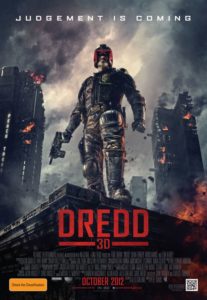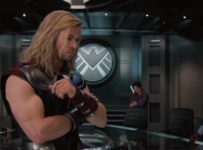Fun and bloody, the latest adaptation of a classic comic-book character revels in ultra-violence and takes no prisoners in the process.
[stextbox id=”grey” caption=”Dredd (2012)” float=”true” align=”right” width=”200″]
Director: Pete Travis
Writer: Alex Garland
Runtime: 95 minutes
Starring: Karl Urban, Olivia Thirlby, Wood Harris, Lena Headey
Distributor: Icon
Country: UK, South Africa
Rating (?): Highly Recommended (★★★★)
Judge Dredd first appeared in Britain in the pages of 2000 AD’s second issue in 1977, but was ultimately a response to the seemingly fascist police state being created by Margaret Thatcher in the following years. So it is entirely appropriate that the latest version of John Wagner’s creation should reappear when law enforcement bodies have even more power than ever to be judge, juries and executioners in a response to the global threat of terror. With the bad taste of the Sylvester Stallone vehicle Judge Dredd (1995) still lingering in the back palate of both film and comic fans everywhere, the not inconsiderable talents of writer Alex Garland have been brought in to render one of the most brutal screen versions of a comic book character to date.
Garland’s Dredd draws from a number of different sources, but is most effective as a straightforward narrative about a veteran Judge Dredd (Karl Urban) forced to take the psychic rookie Anderson (Olivia Thirlby) under his wing on a very bad day. In the massive irradiated wasteland of futuristic America, the vast metropolis of Mega-City One stands, housing 800 million citizens and 17,000 crimes daily. The Judges keep what order they can by immediately punishing infractions with on-the-spot death. Plagued by a new drug known as Slow-Mo, which tricks the brain into seeing the world at a fraction of its normal speed, Dredd and Anderson are called into the 200-story slum tower block Peach Trees, where several murders have been reported. They find a tower run by Ma Ma Madrigal (Lena Headey), a former prostitute turned gang lord, who runs the biggest distribution of Slow-Mo out of her fiefdom. Locked in the tower with scores of itchy trigger fingers, and a prisoner (Wood Harris) in tow, the Judges must fight their way to the top and see that justice is done.
Dredd has a number of similarities to last year’s surprise Indonesian hit The Raid (2011), and indeed their basic premises of a handful of cops in a well-armed block are identical. Yet Garland’s script immediately distinguishes itself by taking itself far less seriously, not treating the material lightly but rather finding the ironic humour that serves as a major selling point in the original comics. The concept of the “block wars” has long been a staple in the Judge Dredd source material, and here it serves as a playground for an endless series of bloody deaths, each one escalating in the splatter factor. Rather than feeling like a relentless video game, one where everybody is a NPC, the black-and-white attitude of Dredd grounds the picture with an unwavering brutality that doesn’t let up until the very end.
Much of this is attributable to the compelling central character, Urban makes a terrific Dredd, all the more impressive given that he is acting entirely from the bottom half of his face. Wearing his trademark helmet for the duration of the film this time around, Urban gives a masterclass in economy of movement. Thirlby, in a rare relatable performance, is there to provide accessibility for the average audience member, and achieves this without excessive exposition. Dredd further distinguishes itself from The Raid with the addition of a suitably compelling villain in the Patti Smith inspired character from Heady. Already a genre favourite thanks to her Game of Thrones role, the scarred block lord exudes a cruel and casual indifference, but her immediately at odds with the black-letter law Dredd. Yet it is in watching the Judge begin to realise the folly of his totalitarian system over the course of the film that is one of the real joys for fans.
With a look that is equal parts Blade Runner (1982) and western, Dredd is a satisfying union of comic book and cinematic flair. Largely said to be co-directed and edited by writer Garland, instead of director Pete Travis, we finally get a reasonable use for slow-motion and 3D, giving us a visual interpretation of the comics that could only exist on film, but is wholly indebted to its origins. Shot in South Africa with a comparatively small budget of $45, every bit of it can be seen on-screen, not wasting a single moment of this opportunity to get it right. While some might have cause to complain about the excessive nature of the violence, it would be like calling the sun “too hot”. Dredd is a film that knows its audience and fulfils its promise and purpose, gleefully kicking down the door and leaving doubters in a bloody pulp.
Dredd is released in Australia on 25 October 2012 from Icon Film Distribution.





